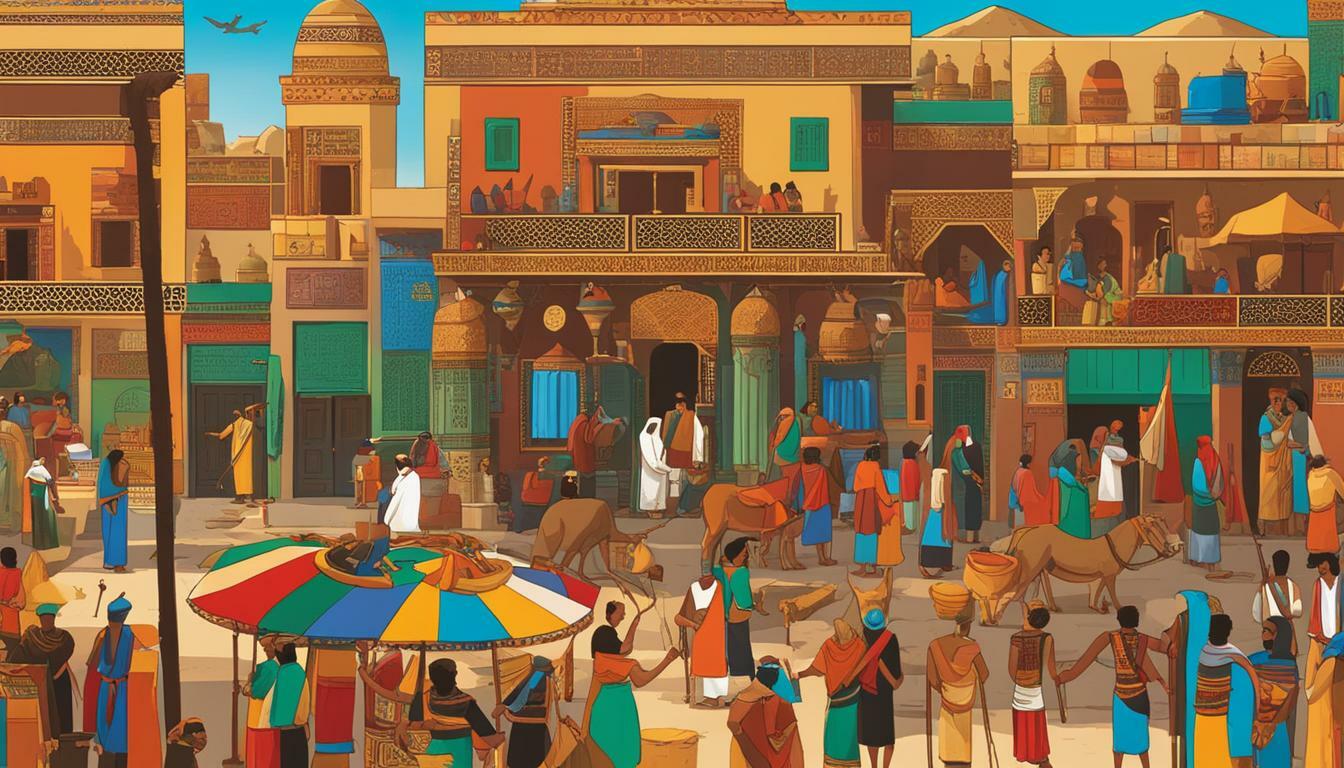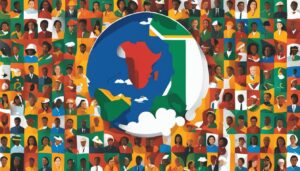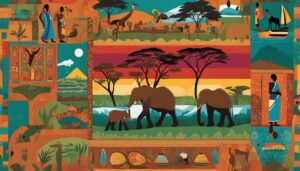Egypt is a country rich in linguistic diversity, but the main language spoken by the majority of its population is Arabic. Egyptian Arabic, a dialect of Arabic, is the most commonly spoken language in the country. In addition to Egyptian Arabic, there are other spoken Arabic variants throughout Egypt, including Sa’idi Arabic and Sudanese Arabic. Modern Standard Arabic is the official language of Egypt and is used in written documents and schools.
Key Takeaways
- Egypt’s main language is Arabic, with Egyptian Arabic being the most commonly spoken dialect.
- Modern Standard Arabic is the official language and is used in written documents and schools.
- Other spoken Arabic variants exist in Egypt, such as Sa’idi Arabic and Sudanese Arabic.
- Linguistic minorities in Egypt speak languages like Tigrinya, Berber languages, and languages belonging to the Nilo-Saharan family.
- English and French are commonly spoken as second languages in Egypt.
The Official Language and Common Dialects
Modern Standard Arabic is the official language of Egypt and is used in official documents, schools, and formal settings, while Egyptian Arabic is the most widely spoken dialect by the Egyptian people. Modern Standard Arabic, also known as Literary Arabic, is based on the classical Arabic language and is the form of Arabic used in written communication throughout the Arab world.
Egyptian Arabic, on the other hand, is the spoken language used in everyday conversations and informal settings. It is a distinct dialect with its own unique vocabulary, pronunciation, and grammar. Egyptian Arabic is widely understood by other Arabic speakers due to the influence of Egyptian media and entertainment industry.
To better understand the linguistic landscape of Egypt, it is important to highlight the diversity of Arabic dialects spoken within the country. Some other notable dialects include Sa’idi Arabic, spoken in Upper Egypt, and Sudanese Arabic, spoken by Sudanese communities residing in Egypt.
The Official Language and Common Dialects:
| Language | Type | Usage |
|---|---|---|
| Modern Standard Arabic | Official language | Written communication, formal settings |
| Egyptian Arabic | Spoken dialect | Everyday conversations, informal settings |
| Sa’idi Arabic | Regional dialect | Spoken in Upper Egypt |
| Sudanese Arabic | Spoken dialect | Spoken by Sudanese communities in Egypt |
In addition to Arabic, Egypt is also home to linguistic minorities that speak languages like Tigrinya, which belongs to the Afro-Asiatic family, as well as various Berber languages and languages belonging to the Nilo-Saharan family. These minority languages represent the cultural diversity within Egypt.
Furthermore, due to historical factors and international influences, there are other languages spoken in Egypt. English and French, for example, are commonly spoken as second languages, especially in tourist areas and among the educated population. Additionally, there are immigrant communities in Egypt that speak languages like Italian and Armenian, adding to the linguistic tapestry of the country.
While the ancient Egyptian language, hieroglyphics, and Coptic have historical significance, they are not widely spoken today. These languages provide insights into Egypt’s rich linguistic history and cultural heritage.
Other Spoken Variants
In addition to Egyptian Arabic, there are other Arabic variants spoken in different regions of Egypt. One of these variants is Sa’idi Arabic, which is predominantly spoken in Upper Egypt. It is characterized by its unique vocabulary, pronunciation, and accent, setting it apart from other Arabic dialects. Sa’idi Arabic reflects the cultural heritage of the people of Upper Egypt and their distinct way of life.
Another Arabic variant spoken in Egypt is Sudanese Arabic, primarily found in areas close to the Sudanese border. Due to the geographical proximity and historical ties between Egypt and Sudan, Sudanese Arabic has influenced the dialect spoken in these areas. It incorporates vocabulary and expressions from Sudanese Arabic, making it distinct from other Egyptian dialects.
Regional Differences
It’s important to note that these Arabic variants can vary even further within the regions where they are spoken. For example, there may be differences in pronunciation, vocabulary, and grammar between towns or villages in the same region. These regional variations contribute to the rich linguistic tapestry of Egypt and highlight the diversity within the country.
Overall, the linguistic landscape of Egypt is shaped by various Arabic variants, each with its own unique characteristics and regional influences. These dialects not only reflect the cultural heritage and history of the Egyptian people but also contribute to the vibrant linguistic diversity found in the country.
| Arabic Variant | Region |
|---|---|
| Sa’idi Arabic | Upper Egypt |
| Sudanese Arabic | Areas close to the Sudanese border |
Linguistic Minorities
Alongside Arabic, Egypt is home to various linguistic minorities who speak languages like Tigrinya, Berber languages, and languages from the Nilo-Saharan family. These communities add to the linguistic diversity of the country and contribute to its cultural fabric.
Tigrinya, a Semitic language belonging to the Afro-Asiatic language family, is primarily spoken by the Tigrinya ethnic group who trace their roots back to Eritrea and Ethiopia. They have settled in Egypt over generations, and their language has become a part of the broader linguistic landscape in certain areas.
Berber languages, another set of Afro-Asiatic languages, are spoken by the Berber ethnic group, who are indigenous to North Africa. While Berber languages are most commonly associated with countries like Morocco and Algeria, there are Berber-speaking communities in Egypt as well. These languages have a rich oral tradition and are an integral component of Berber cultural heritage.
The Nilo-Saharan language family comprises a group of languages spoken in the Nile Valley and the broader Sahel region. In Egypt, some linguistic minorities speak languages from this family, such as Fur, Nubian, and Beja. These languages reflect the historical and cultural links between Egypt and neighboring African countries.
| Linguistic Minority | Language | Language Family |
|---|---|---|
| Tigrinya | Tigrinya language | Afro-Asiatic |
| Berber | Berber languages | Afro-Asiatic |
| Nilo-Saharan | Fur, Nubian, Beja, etc. | Nilo-Saharan |
These linguistic minorities contribute to the cultural diversity of Egypt, preserving their heritage, and enriching the linguistic tapestry of the country. While Arabic remains the dominant language, the presence of these linguistic minorities highlights the multiethnic and multicultural nature of Egypt.
Influence of Other Languages
While Arabic is the predominant language, English and French are widely spoken as second languages in Egypt, and there are communities of Italian and Armenian speakers who bring their languages to the linguistic landscape.
In the bustling streets of Cairo or the historic neighborhoods of Alexandria, it’s not uncommon to hear snippets of English or French conversations. English has gained popularity as a result of its widespread usage in education, media, and tourism. Many Egyptians learn English from an early age and use it as a means to communicate with foreigners.
“English has become an essential tool for economic and educational development in Egypt,” says Dr. Ahmed, a linguistic expert at Cairo University.
French, on the other hand, holds historical significance due to Egypt’s strong ties with France during the colonial era. It continues to be spoken by a significant portion of the population, particularly among the older generation and in certain cultural communities.
In addition to English and French, Egypt is also home to thriving communities of Italian and Armenian speakers. The Italian community in Egypt dates back centuries, with a rich history of trade and cultural exchange. The descendants of Italian immigrants have maintained their language and cultural traditions, contributing to the linguistic diversity of the country.
Similarly, the Armenian community in Egypt has preserved its language and heritage, with Armenian being spoken in homes, schools, and community gatherings. This linguistic mosaic reflects the multicultural fabric of Egyptian society.
Table: Languages in Egypt
Here is a breakdown of the languages spoken in Egypt:
| Language | Usage |
|---|---|
| Arabic | Predominantly spoken, official language |
| English | Commonly spoken as a second language |
| French | Commonly spoken as a second language |
| Italian | Spoken by Italian community |
| Armenian | Spoken by Armenian community |
Historical Significance
Egypt has a rich linguistic history, with languages like the ancient Egyptian language, hieroglyphics, and Coptic playing significant roles, but these languages are not in common use today. The ancient Egyptian language, also known as Middle Egyptian or Classical Egyptian, was spoken from around 3200 BC to 1350 BC. It is the oldest known stage of the Egyptian language and was primarily used for religious, administrative, and literary purposes.
One of the most fascinating aspects of ancient Egyptian language is hieroglyphics. Hieroglyphics were a system of writing consisting of pictorial symbols that represented sounds, words, and ideas. The word “hieroglyphics” is derived from the Greek words “hieros,” meaning sacred, and “glyphein,” meaning to carve or inscribe. These intricate symbols were used to record important religious and historical events, as well as to decorate temples and tombs.
Coptic is another significant language in Egypt’s linguistic history. It is a form of the Egyptian language that developed after the spread of Christianity in Egypt. Coptic was used as the written language of the native Egyptian Christians and was written using the Greek alphabet with added characters. Today, Coptic is mainly used liturgically in the Coptic Orthodox Church.
| Ancient Egyptian language | Hieroglyphics | Coptic |
|---|---|---|
| Ancient stage of the Egyptian language, spoken from 3200 BC to 1350 BC | A system of writing consisting of pictorial symbols | A form of the Egyptian language used by Egyptian Christians, written using the Greek alphabet with added characters |
Understanding Language in Egypt
Egypt’s linguistic diversity is a testament to its rich history and cultural heritage, with Arabic being the main language spoken and various dialects and linguistic minorities adding to the tapestry of communication in this ancient land.
The official language of Egypt is Modern Standard Arabic, which is used in written documents and taught in schools. However, the most commonly spoken dialect is Egyptian Arabic, which differs slightly from the standard form. This dialect is the language of everyday conversations and is understood by the majority of Egyptians.
In addition to Egyptian Arabic, there are other spoken Arabic variants found throughout the country. Sa’idi Arabic is spoken in Upper Egypt, while Sudanese Arabic is spoken in the northern parts of Sudan along the Egyptian border. These variants have their own unique characteristics and are influenced by the local culture and history of the regions.
Aside from the Arabic language, Egypt is also home to linguistic minorities that speak different languages. These include Tigrinya, which is spoken by the Tigrinya people, as well as various Berber languages and languages belonging to the Nilo-Saharan family. These minority languages reflect the diverse ethnic groups present in Egypt.
Furthermore, the influence of other languages can also be observed in Egypt. English and French are commonly spoken as second languages, particularly in urban areas and among the educated population. Immigrant communities, such as the Italian and Armenian communities, also contribute to the linguistic landscape by speaking their native languages. This linguistic diversity adds depth to Egypt’s cultural fabric.
While the ancient Egyptian language, hieroglyphics, and Coptic have historical significance, they are not widely spoken today. Nonetheless, they remain an important part of Egypt’s linguistic history and heritage.
Overall, Egypt’s linguistic landscape is a reflection of its rich past and vibrant present, showcasing the influence of different cultures and languages. Whether it’s the official language of Modern Standard Arabic, the everyday conversations in Egyptian Arabic, or the various spoken and minority languages, language plays a pivotal role in shaping Egypt’s identity.
FAQ
What is the main language spoken in Egypt?
The main language spoken in Egypt is Arabic.
What is the official language of Egypt?
The official language of Egypt is Modern Standard Arabic.
Is Egyptian Arabic different from Modern Standard Arabic?
Yes, Egyptian Arabic is a commonly spoken dialect that differs from the formal Modern Standard Arabic.
Are there other spoken Arabic variants in Egypt?
Yes, there are other spoken Arabic variants in Egypt such as Sa’idi Arabic and Sudanese Arabic.
Are there linguistic minorities in Egypt?
Yes, there are linguistic minorities in Egypt who speak languages like Tigrinya, Berber languages, and languages belonging to the Nilo-Saharan family.
What other languages are commonly spoken in Egypt?
English and French are commonly spoken as second languages in Egypt. There are also immigrant communities that speak languages like Italian and Armenian.
Do people in Egypt still speak ancient Egyptian or hieroglyphics?
No, ancient Egyptian and hieroglyphics are not widely spoken today, but they hold historical significance in Egypt.
What is Egyptian Sign Language?
Egyptian Sign Language is a sign language used by the deaf community in Egypt.
How diverse is the linguistic landscape of Egypt?
The linguistic landscape of Egypt is diverse, with various languages spoken, the importance of Arabic, and historical significance of different languages in the country.



